Evaluating Australia's National Health Reforms: A Critical Analysis
VerifiedAdded on 2023/06/09
|6
|1178
|460
Essay
AI Summary
This essay examines the extent to which national health reforms in Australia are influenced by strategic decision-making versus political agendas. It highlights the Australian government's investment in healthcare to ensure affordable and accessible services, particularly for Aboriginal and Torres Strait Islander populations, aiming to reduce health inequalities. While strategic approaches are evident in structural reforms and initiatives like after-hours GP telephone advice, gaps remain in addressing social determinants of health. The essay also discusses the political motivations behind cost-effective healthcare investments and concludes that while political agendas exist, many reforms demonstrate a strategic approach to improving healthcare delivery and reducing health inequalities. Desklib offers similar solved assignments for students.
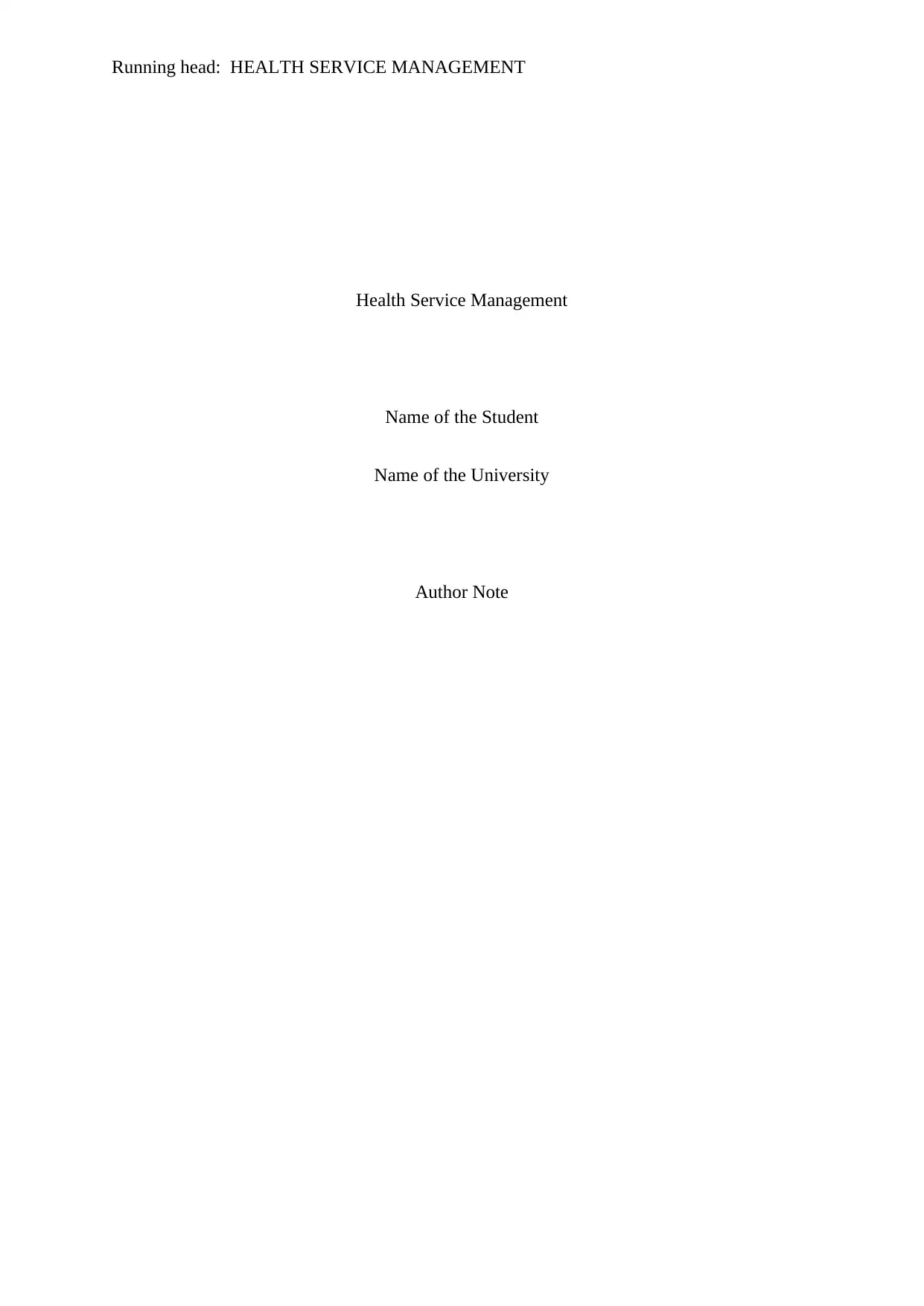
Running head: HEALTH SERVICE MANAGEMENT
Health Service Management
Name of the Student
Name of the University
Author Note
Health Service Management
Name of the Student
Name of the University
Author Note
Paraphrase This Document
Need a fresh take? Get an instant paraphrase of this document with our AI Paraphraser
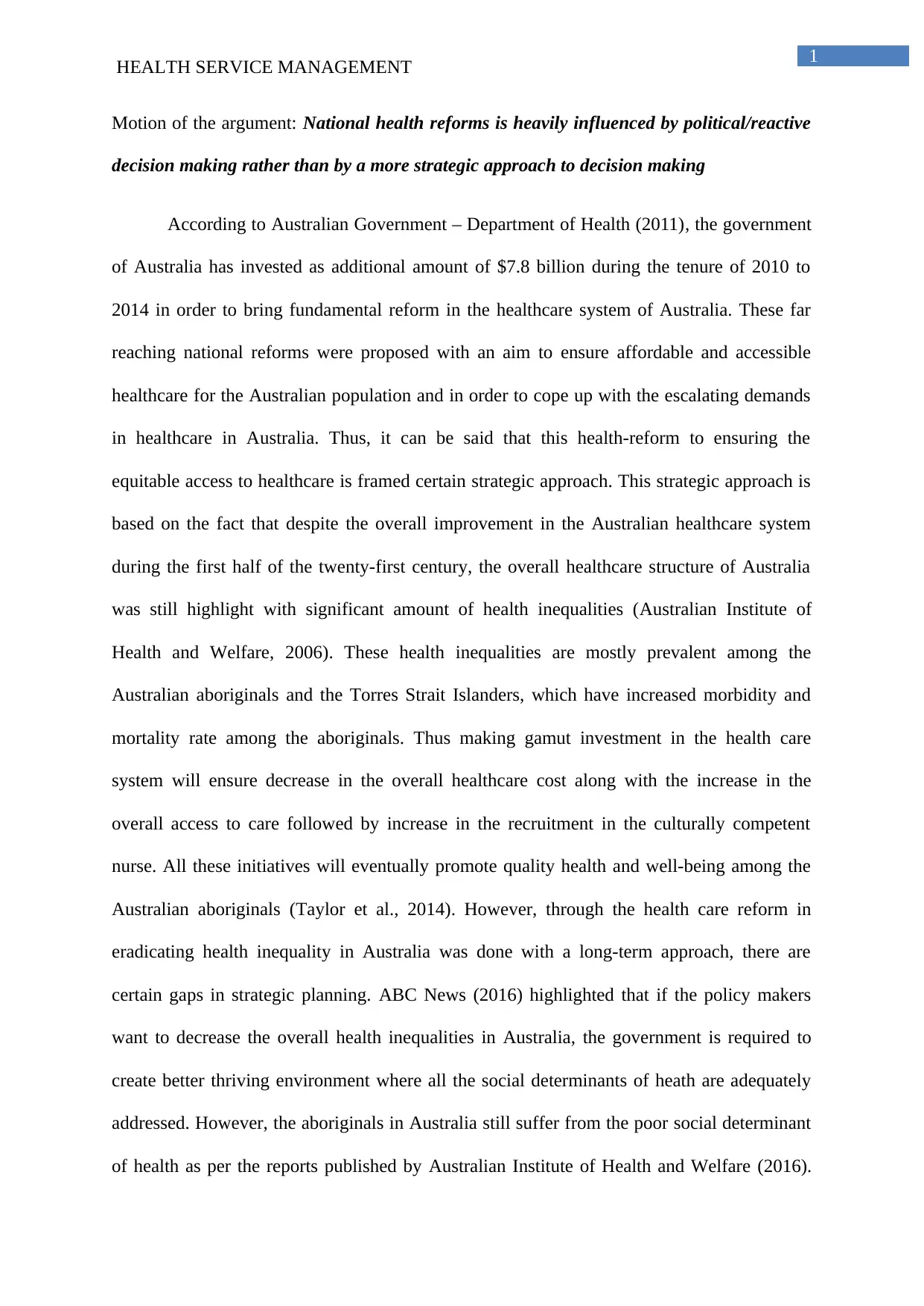
1
HEALTH SERVICE MANAGEMENT
Motion of the argument: National health reforms is heavily influenced by political/reactive
decision making rather than by a more strategic approach to decision making
According to Australian Government – Department of Health (2011), the government
of Australia has invested as additional amount of $7.8 billion during the tenure of 2010 to
2014 in order to bring fundamental reform in the healthcare system of Australia. These far
reaching national reforms were proposed with an aim to ensure affordable and accessible
healthcare for the Australian population and in order to cope up with the escalating demands
in healthcare in Australia. Thus, it can be said that this health-reform to ensuring the
equitable access to healthcare is framed certain strategic approach. This strategic approach is
based on the fact that despite the overall improvement in the Australian healthcare system
during the first half of the twenty-first century, the overall healthcare structure of Australia
was still highlight with significant amount of health inequalities (Australian Institute of
Health and Welfare, 2006). These health inequalities are mostly prevalent among the
Australian aboriginals and the Torres Strait Islanders, which have increased morbidity and
mortality rate among the aboriginals. Thus making gamut investment in the health care
system will ensure decrease in the overall healthcare cost along with the increase in the
overall access to care followed by increase in the recruitment in the culturally competent
nurse. All these initiatives will eventually promote quality health and well-being among the
Australian aboriginals (Taylor et al., 2014). However, through the health care reform in
eradicating health inequality in Australia was done with a long-term approach, there are
certain gaps in strategic planning. ABC News (2016) highlighted that if the policy makers
want to decrease the overall health inequalities in Australia, the government is required to
create better thriving environment where all the social determinants of heath are adequately
addressed. However, the aboriginals in Australia still suffer from the poor social determinant
of health as per the reports published by Australian Institute of Health and Welfare (2016).
HEALTH SERVICE MANAGEMENT
Motion of the argument: National health reforms is heavily influenced by political/reactive
decision making rather than by a more strategic approach to decision making
According to Australian Government – Department of Health (2011), the government
of Australia has invested as additional amount of $7.8 billion during the tenure of 2010 to
2014 in order to bring fundamental reform in the healthcare system of Australia. These far
reaching national reforms were proposed with an aim to ensure affordable and accessible
healthcare for the Australian population and in order to cope up with the escalating demands
in healthcare in Australia. Thus, it can be said that this health-reform to ensuring the
equitable access to healthcare is framed certain strategic approach. This strategic approach is
based on the fact that despite the overall improvement in the Australian healthcare system
during the first half of the twenty-first century, the overall healthcare structure of Australia
was still highlight with significant amount of health inequalities (Australian Institute of
Health and Welfare, 2006). These health inequalities are mostly prevalent among the
Australian aboriginals and the Torres Strait Islanders, which have increased morbidity and
mortality rate among the aboriginals. Thus making gamut investment in the health care
system will ensure decrease in the overall healthcare cost along with the increase in the
overall access to care followed by increase in the recruitment in the culturally competent
nurse. All these initiatives will eventually promote quality health and well-being among the
Australian aboriginals (Taylor et al., 2014). However, through the health care reform in
eradicating health inequality in Australia was done with a long-term approach, there are
certain gaps in strategic planning. ABC News (2016) highlighted that if the policy makers
want to decrease the overall health inequalities in Australia, the government is required to
create better thriving environment where all the social determinants of heath are adequately
addressed. However, the aboriginals in Australia still suffer from the poor social determinant
of health as per the reports published by Australian Institute of Health and Welfare (2016).
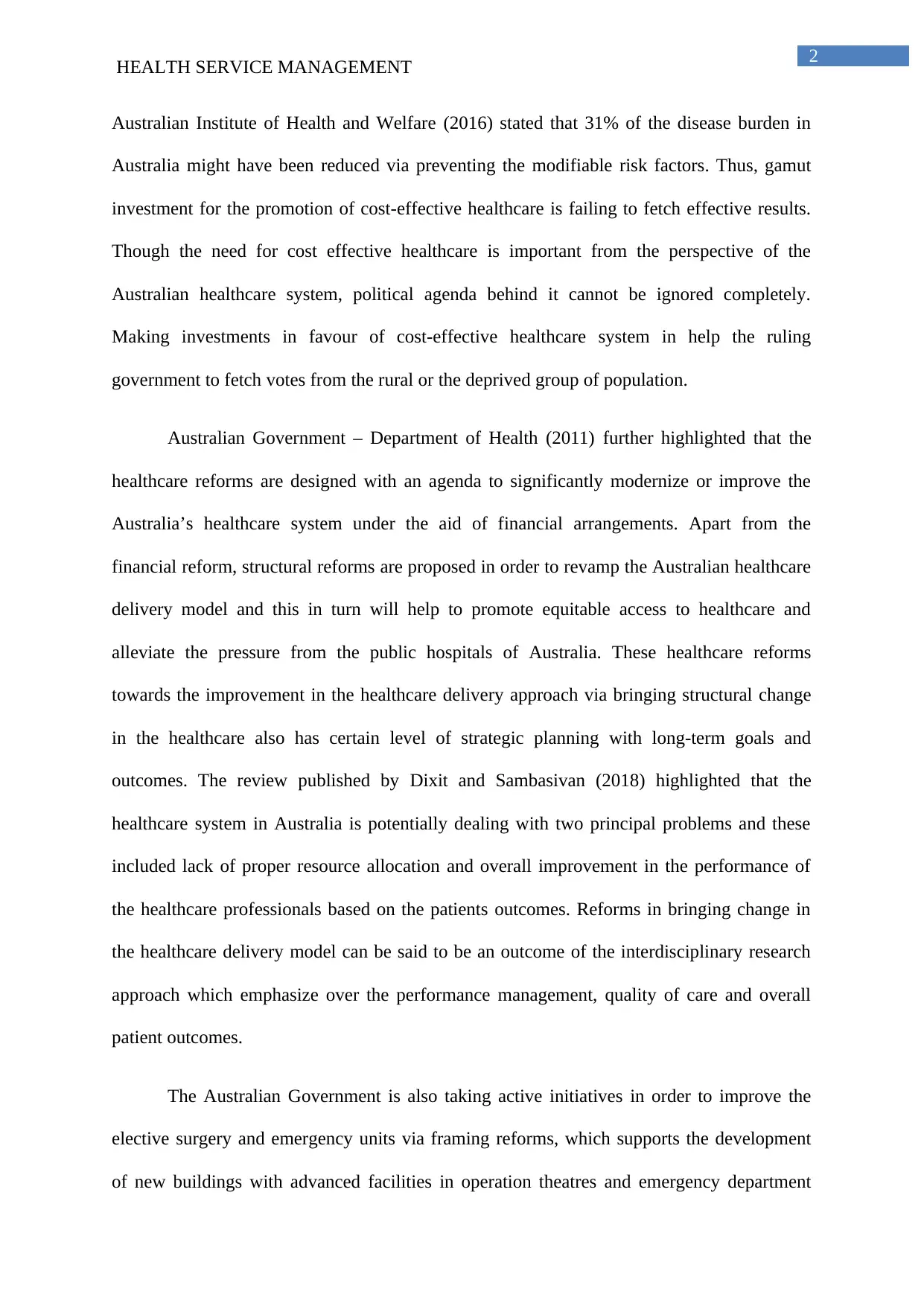
2
HEALTH SERVICE MANAGEMENT
Australian Institute of Health and Welfare (2016) stated that 31% of the disease burden in
Australia might have been reduced via preventing the modifiable risk factors. Thus, gamut
investment for the promotion of cost-effective healthcare is failing to fetch effective results.
Though the need for cost effective healthcare is important from the perspective of the
Australian healthcare system, political agenda behind it cannot be ignored completely.
Making investments in favour of cost-effective healthcare system in help the ruling
government to fetch votes from the rural or the deprived group of population.
Australian Government – Department of Health (2011) further highlighted that the
healthcare reforms are designed with an agenda to significantly modernize or improve the
Australia’s healthcare system under the aid of financial arrangements. Apart from the
financial reform, structural reforms are proposed in order to revamp the Australian healthcare
delivery model and this in turn will help to promote equitable access to healthcare and
alleviate the pressure from the public hospitals of Australia. These healthcare reforms
towards the improvement in the healthcare delivery approach via bringing structural change
in the healthcare also has certain level of strategic planning with long-term goals and
outcomes. The review published by Dixit and Sambasivan (2018) highlighted that the
healthcare system in Australia is potentially dealing with two principal problems and these
included lack of proper resource allocation and overall improvement in the performance of
the healthcare professionals based on the patients outcomes. Reforms in bringing change in
the healthcare delivery model can be said to be an outcome of the interdisciplinary research
approach which emphasize over the performance management, quality of care and overall
patient outcomes.
The Australian Government is also taking active initiatives in order to improve the
elective surgery and emergency units via framing reforms, which supports the development
of new buildings with advanced facilities in operation theatres and emergency department
HEALTH SERVICE MANAGEMENT
Australian Institute of Health and Welfare (2016) stated that 31% of the disease burden in
Australia might have been reduced via preventing the modifiable risk factors. Thus, gamut
investment for the promotion of cost-effective healthcare is failing to fetch effective results.
Though the need for cost effective healthcare is important from the perspective of the
Australian healthcare system, political agenda behind it cannot be ignored completely.
Making investments in favour of cost-effective healthcare system in help the ruling
government to fetch votes from the rural or the deprived group of population.
Australian Government – Department of Health (2011) further highlighted that the
healthcare reforms are designed with an agenda to significantly modernize or improve the
Australia’s healthcare system under the aid of financial arrangements. Apart from the
financial reform, structural reforms are proposed in order to revamp the Australian healthcare
delivery model and this in turn will help to promote equitable access to healthcare and
alleviate the pressure from the public hospitals of Australia. These healthcare reforms
towards the improvement in the healthcare delivery approach via bringing structural change
in the healthcare also has certain level of strategic planning with long-term goals and
outcomes. The review published by Dixit and Sambasivan (2018) highlighted that the
healthcare system in Australia is potentially dealing with two principal problems and these
included lack of proper resource allocation and overall improvement in the performance of
the healthcare professionals based on the patients outcomes. Reforms in bringing change in
the healthcare delivery model can be said to be an outcome of the interdisciplinary research
approach which emphasize over the performance management, quality of care and overall
patient outcomes.
The Australian Government is also taking active initiatives in order to improve the
elective surgery and emergency units via framing reforms, which supports the development
of new buildings with advanced facilities in operation theatres and emergency department
⊘ This is a preview!⊘
Do you want full access?
Subscribe today to unlock all pages.

Trusted by 1+ million students worldwide
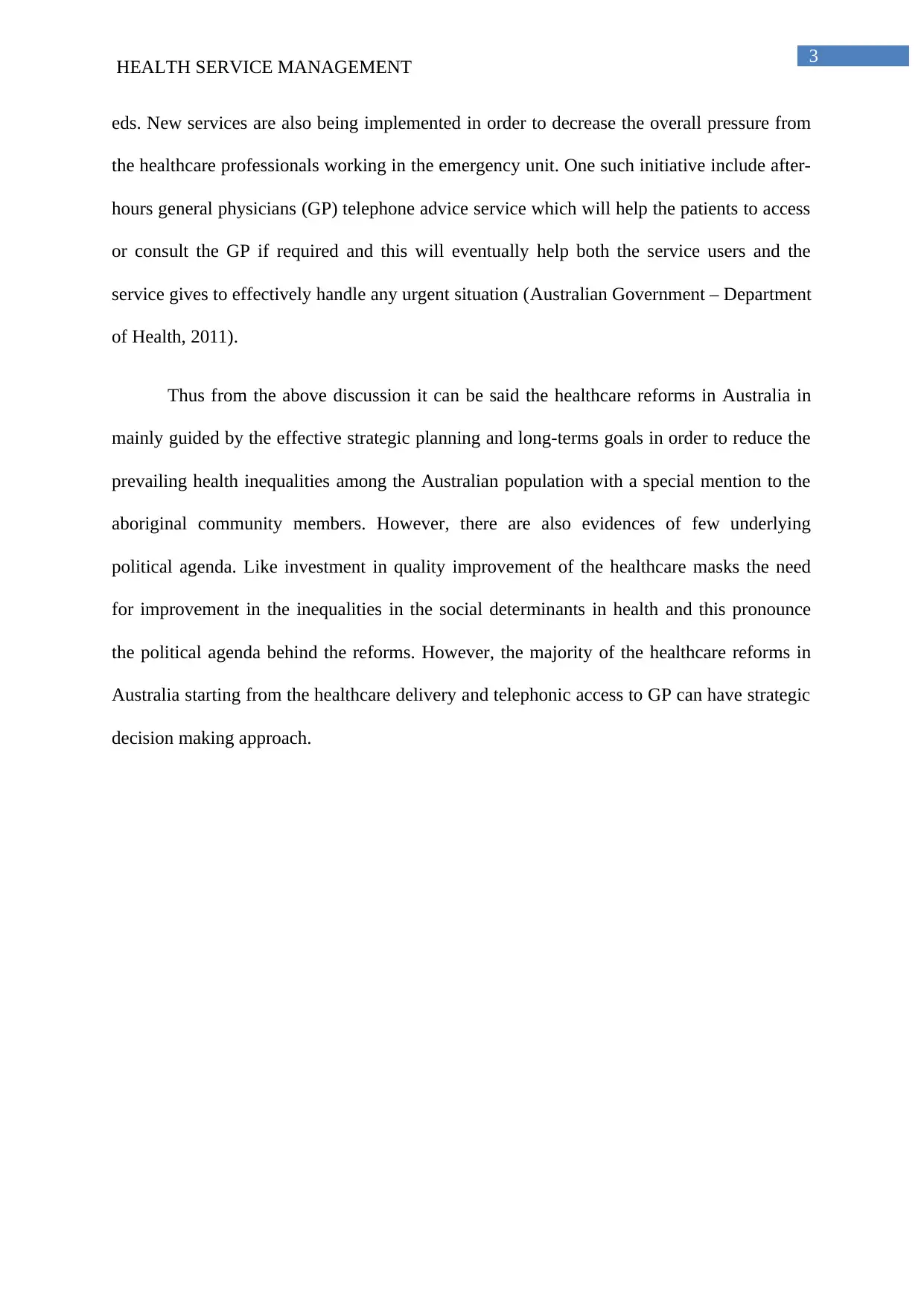
3
HEALTH SERVICE MANAGEMENT
eds. New services are also being implemented in order to decrease the overall pressure from
the healthcare professionals working in the emergency unit. One such initiative include after-
hours general physicians (GP) telephone advice service which will help the patients to access
or consult the GP if required and this will eventually help both the service users and the
service gives to effectively handle any urgent situation (Australian Government – Department
of Health, 2011).
Thus from the above discussion it can be said the healthcare reforms in Australia in
mainly guided by the effective strategic planning and long-terms goals in order to reduce the
prevailing health inequalities among the Australian population with a special mention to the
aboriginal community members. However, there are also evidences of few underlying
political agenda. Like investment in quality improvement of the healthcare masks the need
for improvement in the inequalities in the social determinants in health and this pronounce
the political agenda behind the reforms. However, the majority of the healthcare reforms in
Australia starting from the healthcare delivery and telephonic access to GP can have strategic
decision making approach.
HEALTH SERVICE MANAGEMENT
eds. New services are also being implemented in order to decrease the overall pressure from
the healthcare professionals working in the emergency unit. One such initiative include after-
hours general physicians (GP) telephone advice service which will help the patients to access
or consult the GP if required and this will eventually help both the service users and the
service gives to effectively handle any urgent situation (Australian Government – Department
of Health, 2011).
Thus from the above discussion it can be said the healthcare reforms in Australia in
mainly guided by the effective strategic planning and long-terms goals in order to reduce the
prevailing health inequalities among the Australian population with a special mention to the
aboriginal community members. However, there are also evidences of few underlying
political agenda. Like investment in quality improvement of the healthcare masks the need
for improvement in the inequalities in the social determinants in health and this pronounce
the political agenda behind the reforms. However, the majority of the healthcare reforms in
Australia starting from the healthcare delivery and telephonic access to GP can have strategic
decision making approach.
Paraphrase This Document
Need a fresh take? Get an instant paraphrase of this document with our AI Paraphraser
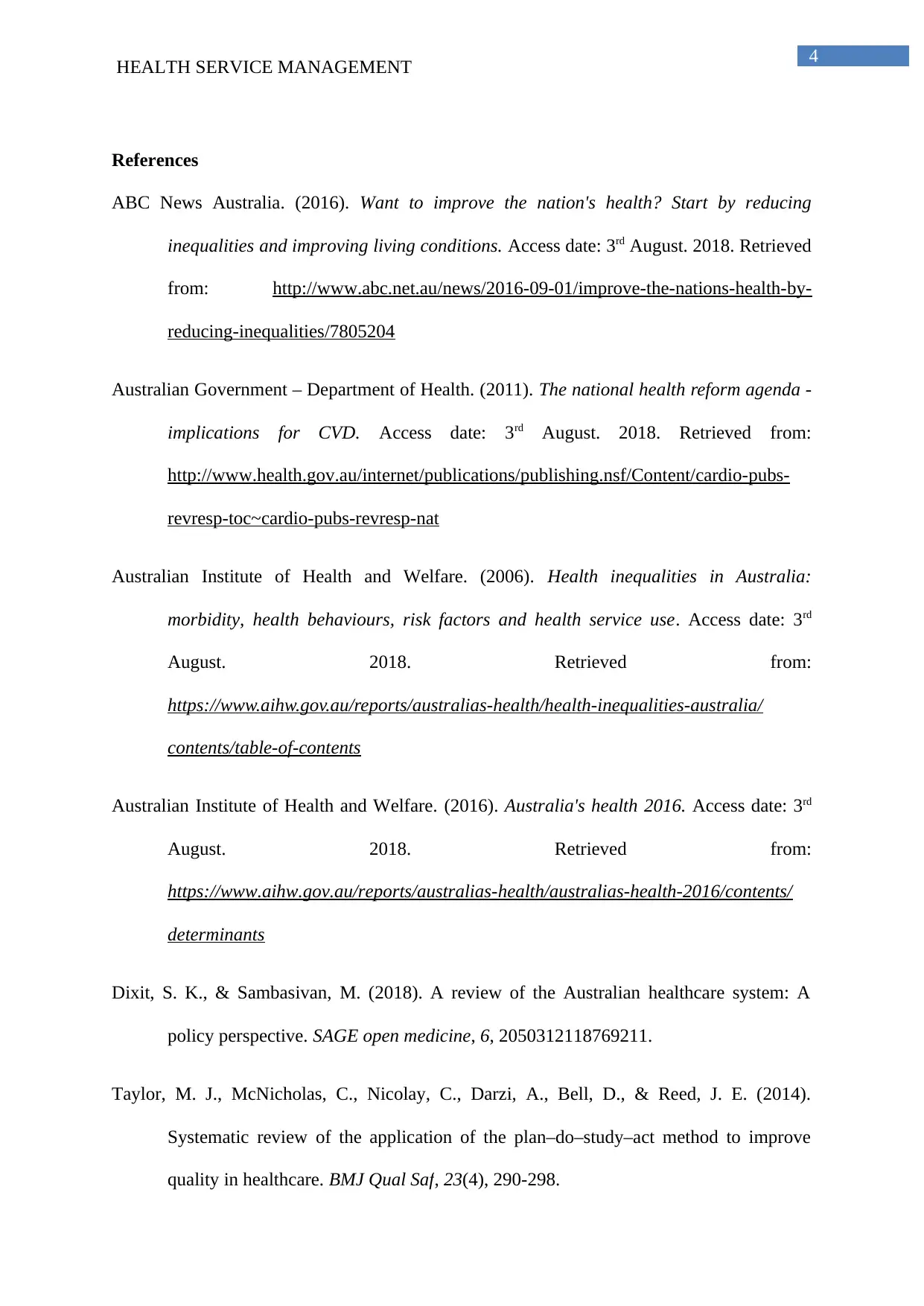
4
HEALTH SERVICE MANAGEMENT
References
ABC News Australia. (2016). Want to improve the nation's health? Start by reducing
inequalities and improving living conditions. Access date: 3rd August. 2018. Retrieved
from: http://www.abc.net.au/news/2016-09-01/improve-the-nations-health-by-
reducing-inequalities/7805204
Australian Government – Department of Health. (2011). The national health reform agenda -
implications for CVD. Access date: 3rd August. 2018. Retrieved from:
http://www.health.gov.au/internet/publications/publishing.nsf/Content/cardio-pubs-
revresp-toc~cardio-pubs-revresp-nat
Australian Institute of Health and Welfare. (2006). Health inequalities in Australia:
morbidity, health behaviours, risk factors and health service use. Access date: 3rd
August. 2018. Retrieved from:
https://www.aihw.gov.au/reports/australias-health/health-inequalities-australia/
contents/table-of-contents
Australian Institute of Health and Welfare. (2016). Australia's health 2016. Access date: 3rd
August. 2018. Retrieved from:
https://www.aihw.gov.au/reports/australias-health/australias-health-2016/contents/
determinants
Dixit, S. K., & Sambasivan, M. (2018). A review of the Australian healthcare system: A
policy perspective. SAGE open medicine, 6, 2050312118769211.
Taylor, M. J., McNicholas, C., Nicolay, C., Darzi, A., Bell, D., & Reed, J. E. (2014).
Systematic review of the application of the plan–do–study–act method to improve
quality in healthcare. BMJ Qual Saf, 23(4), 290-298.
HEALTH SERVICE MANAGEMENT
References
ABC News Australia. (2016). Want to improve the nation's health? Start by reducing
inequalities and improving living conditions. Access date: 3rd August. 2018. Retrieved
from: http://www.abc.net.au/news/2016-09-01/improve-the-nations-health-by-
reducing-inequalities/7805204
Australian Government – Department of Health. (2011). The national health reform agenda -
implications for CVD. Access date: 3rd August. 2018. Retrieved from:
http://www.health.gov.au/internet/publications/publishing.nsf/Content/cardio-pubs-
revresp-toc~cardio-pubs-revresp-nat
Australian Institute of Health and Welfare. (2006). Health inequalities in Australia:
morbidity, health behaviours, risk factors and health service use. Access date: 3rd
August. 2018. Retrieved from:
https://www.aihw.gov.au/reports/australias-health/health-inequalities-australia/
contents/table-of-contents
Australian Institute of Health and Welfare. (2016). Australia's health 2016. Access date: 3rd
August. 2018. Retrieved from:
https://www.aihw.gov.au/reports/australias-health/australias-health-2016/contents/
determinants
Dixit, S. K., & Sambasivan, M. (2018). A review of the Australian healthcare system: A
policy perspective. SAGE open medicine, 6, 2050312118769211.
Taylor, M. J., McNicholas, C., Nicolay, C., Darzi, A., Bell, D., & Reed, J. E. (2014).
Systematic review of the application of the plan–do–study–act method to improve
quality in healthcare. BMJ Qual Saf, 23(4), 290-298.

5
HEALTH SERVICE MANAGEMENT
HEALTH SERVICE MANAGEMENT
⊘ This is a preview!⊘
Do you want full access?
Subscribe today to unlock all pages.

Trusted by 1+ million students worldwide
1 out of 6
Related Documents
Your All-in-One AI-Powered Toolkit for Academic Success.
+13062052269
info@desklib.com
Available 24*7 on WhatsApp / Email
![[object Object]](/_next/static/media/star-bottom.7253800d.svg)
Unlock your academic potential
Copyright © 2020–2025 A2Z Services. All Rights Reserved. Developed and managed by ZUCOL.





